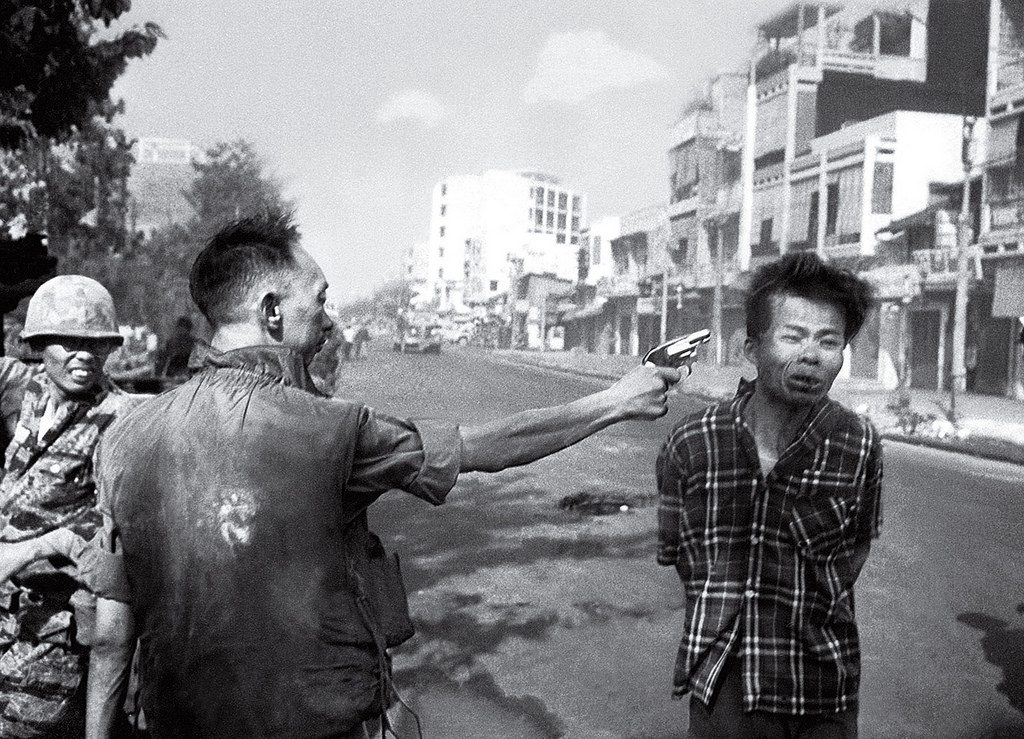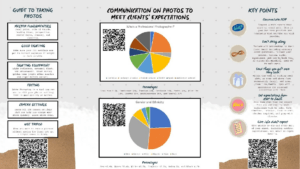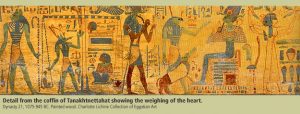Winner of the Fall 2018 StMU History Media Award for
Article with the Best Use of Images
Article with the Best Introduction
The year was 1968. The month of January was almost over and “Tet,” the Vietnamese Lunar New Year, was about to begin. By now, Vietnam had been embroiled for years in a civil war. North Vietnam was under the leadership of a Communist government and South Vietnam was under the leadership of a government that was backed by West. The start of Tet in 1968 was used to launch a huge offensive by the Vietcong in which coordinated attacks took place all over South Vietnam to destabilize the region and push the United States to withdraw.1
The United States‘ intervention in Vietnam began in 1965, a year after the unwarranted attacks by North Vietnam on United States‘ Destroyer ships in the Gulf of Tonkin. By 1967, the number of American troops on the ground surged.2 Despite being involved in this conflict halfway across the globe, the war did not seem so distant with the steady stream of footage and photographs from the front-lines directly to living rooms all over America. In this regard, Vietnam was unique for being one of the first wars to be filmed and photographed extensively.3 The work done by journalists in Vietnam allowed the world to see what was happening in Vietnam firsthand. Among those in Vietnam documenting the war was Eddie Adams.
Eddie Adams had been involved with photography since an early age. He had been a photographer for his high school newspaper and had done some photography work for weddings. Upon graduating high school, he enlisted in the United States Marine Corp. As a Marine, Adams served as a combat photographer in Korea for almost 3 years. In 1965, in what he describes as an “alcoholic haze,” Adams and a close friend decided they would go to Vietnam to document the war.4 During his time in Vietnam is when Adams took the photograph of the Saigon execution.
The day Adams shot the picture featured above was February 1st. He recalls himself and NBC journalists heading toward Cholon, a section of the city of Saigon, because they heard of a battle taking place there. Adams came upon South Vietnamese Brigadier General Nguyen Ngoc Loan executing a Vietcong soldier, in cold blood, in broad day light, in the middle of the street. Adams recalls himself and the other journalist gathering around Loan as he grabbed the soldier. Adams assumed Loan was only going to threaten the man. In the instant Adams raised his camera to snap a photo, Loan raised his pistol and executed the soldier. Loan explained after, that the Vietcong soldier had killed many Americans and allied Vietnamese soldiers.5
The photograph showed up on all major news evening broadcasts and on the front cover of newspapers all over the world the next morning.6 The execution was also recorded, but the specific angle Adams got in his photograph showed the war in an indescribable way. Peter Braestrup, one of the most versed individuals on the Tet offensive, described the picture as a “kind of ultimate horror story that you captured in living color. But in terms of information it told you almost nothing.”7 His quote could not do more justice. What the world saw was a man who was wincing before certain death. They did not know the man was a part of the Vietcong. In the photograph, he seems to be wearing civilian clothes which misleads one. The man had also recently killed allied soldiers and was found armed during martial law- an offense that justifies the use of force.8 Eddie Adams believed he had done an injustice to Loan. He explained, “General Loan was our guy. We were supporting him… believe me, the Americans did just as bad things. I just happened to see this and shoot it…”9

Despite the Johnson Administration’s attempt to win public support of the war, the images of the war painted a very different picture. Public opinion felt that the war was no longer winnable, rather it was now a matter of how America could save face. Walter Cronkite, a well-respected news-anchor and a strong supporter for the war, was among those whose opinion shifted. It was reported that President Johnson believed “if I lost Cronkite, I’ve lost America.”10 The irony of it all was that the Tet Offensive was largely a failure for the Vietcong in terms of land gained and damage inflicted, but in the end its psychological impact on how Americans believed the war to be going, led to its success.11

While this photo was taken out of context, it did provide small truths of the war. Although the war was going well, horrendous acts were being committed. Eddie Adams and many others were able to expose the world to the atrocious acts being committed during the war. Nick Ut’s photo of a napalm strike on a village, is another photo that came to define the war. Ut’s photograph captured the moment children run away in horror from napalm strikes on their village.12 The shattered innocence and utter despair on the childrens’ faces while soldiers seem calm provides a stark incomprehensible contrast that pulls at the heart. These photographs captured only instances of the war. But in the frozen state of a photograph, one is able to examine and reexamine a photograph and truly take in all its details. There was no propaganda campaign that could ever keep a just people supporting a war when they saw photographs like these.

As journalist, Adams and the others were simply doing their jobs. Horst Faas explained about documenting the war, “I don’t think we influenced the war… [he believed simply that the job of journalist was to] record the suffering, the emotions and the sacrifices of both the Americans and the Vietnamese…”13 Their work allowed for the false reality America was living to fall apart. As Americans lived, worked, and played, the very basic rights all humans are entitled to were violated by both sides. As such, Americans responded. In 1973, with public support overwhelmingly against the war in Vietnam, the United States signed the Paris Agreement that led to the withdrawal of all American troops.14 The involvement of the United States in Vietnam continues to be synonymous with some of the most appalling violations of human rights, not only violations against Vietnamese civilians burned alive with napalm or killed slowly through cancer with massive exposure to Agent Orange, but also of the atrocities committed or witnessed by US forces. In addition, all US Soldiers exposed to Agent Orange in indirect ways as when combat medics who worked at Clark Air Force Base (Philippines Islands) received the US soldiers injured in Vietnam who had been evacuated by air. These combat medics received soldiers injured in the field in Vietnam covered in Agent Orange with no protocol for decontamination for the injured nor for themselves as medical personnel. Fifty years on and they continue to die from cancers caused by exposure to Agent Orange. While the US left in 1973, the human suffering due to human rights violations done then, continues today. These images changed the public opinion and changed the course of history even when they may have not saved all those involved at the time, they avoided even greater damages and loss of life, for that we are grateful to these powerful images.
- Patrick Hagopian, America in the World, 1776 to the Present: A Supplement to the Dictionary of American History (Farmington Hills, MI: Charles Scribner’s Sons, 2016), 752. ↵
- James H. Willbanks, Vietnam War: A Topical Exploration and Primary Source Collection (Santa Barbara, CA: ABC-CLIO, 2017), 133, 183. ↵
- James H. Willbanks, The Tet Offensive: A Concise History (New York: Columbia University Press, 2007), 5-6. ↵
- Encyclopedia of World Biography, 2nd Edition, s.v. “Eddie Adams” (Detroit: Gale, 2005), 4. ↵
- Encyclopedia of World Biography, 2nd Edition, s.v. “Eddie Adams” (Detroit: Gale, 2005), 4. ↵
- David Culbert, Television’s Visual Impact on Decision-Making in the USA, 1968: The Tet Offensive and Chicago’s Democratic National Convention, Journal of Contemporary History Vol. 33 (1998): 421. ↵
- David Culbert, Television’s Visual Impact on Decision-Making in the USA, 1968: The Tet Offensive and Chicago’s Democratic National Convention, Journal of Contemporary History Vol. 33 (1998): 424. ↵
- David Culbert, Television’s Visual Impact on Decision-Making in the USA, 1968: The Tet Offensive and Chicago’s Democratic National Convention, Journal of Contemporary History Vol. 33 (1998): 423, 426-428 ↵
- Encyclopedia of World Biography, 2nd Edition, s.v. “Eddie Adams” (Detroit: Gale, 2005), 4-5. ↵
- James H. Willbanks, Vietnam War: A Topical Exploration and Primary Source Collection (Santa Barbara, CA: ABC-CLIO, 2017), 255. ↵
- James H. Willbanks, Vietnam War: A Topical Exploration and Primary Source Collection (Santa Barbara, CA: ABC-CLIO, 2017), 249 ↵
- Hal Buell, The Napalm Girl, Vietnam 25, no. 1 (June 2012), 36-39. ↵
- Deborah Stadler, Frontline Focus, Military History 33, no. 6 (March 2017), 56-61. ↵
- “12 Address to the Nation Announcing Conclusion of an Agreement on Ending the War and Restoring Peace in Vietnam. January 23, 1973.” 2001. American Reference Library – Primary Source Documents, (January, 1.) ↵



188 comments
Amariz Puerta
Photography journalism is such a big growing aspect, especially in the Vietnam war just like the article exclaimed. This is so important to bring people in and read, also it shows how photographs are able to capture every single detail, and we are able to look back on them. This is a part of our history we can look back on and better ourselves for the future.
Priscilla Reyes
The image shown is part of our daily life now. Sadly, these acts continue to occur and when I saw this picture, I remembered my hometown in Mexico. The importance of journalists who are thick skinned and have imagination for capturing these moments is important. It was fortunate that we had cameras and the resources to share the pictures of war and I wish I could see more.
Diamond Davidson
I’ve never heard of this story, but I’m glad I did because I didn’t hear anything about this before. This article really amazes me because one photo changed everything, and I’m glad it happen. This article is really great and extremely strong, it hits all the points of a great article. It has pictures that flows with the story and have readers visual what’s happening and makes readers feel like they’re there.
Tala Owens
This article was interesting from beginning to end. It was very insightful on how journalism changed the Vietnam War and the impact it had on the nation. The pictures were able to show everyone what was actually happening since most had absolutely no clue of how bad it was. This exposure allowed people to see how severe and how scary war really is.
Thomas Fraire
When I tapped on this article I was hoping to see the photo of the young lady fleeing from her napalmed town. What’s more, I wish the writer had utilized progressively differing sources when making these articles. I don’t think the creator totally epitomizes the entire story behind the Vietnam war. I recall my dad disclosing to me that military counsels had educated the president that they could have besieged a dam supplying water to all of North Vietnam and won the war effectively. The president had rejected such activity in light of the measure of non-military personnel setbacks.
Danniella Villarreal
This article was amazing, I loved the way it started and the way it ended. I like how it described how photography journalism changed the Vietnam war. When you look at a picture you are able to look back at it over and over again and truly take in every detail possible, the images of the war can paint a very different picture then someone telling stories. I do feel like there is not a lot of information on the way itself, but I loved how instead of this article telling the stories of what happened during the war it told the store of how the photographs impact it.
Tyler Reynolds
When I clicked on this article I was expecting to see the photograph of the little girl running away from her napalmed village. In addition I wish the author had used more diverse sources when making this articles. I don’t think the author entirely encapsulates the whole story behind the Vietnam war. I remember my father telling me that military advisors had informed the president that they could have bombed a dam suppling water to all of north Vietnam and won the war easily. The president had refused such a action because of the amount of civilian casualties.
Claudia Sanchez
A powerful article that examined how photography journalism changed the Vietnam war. One could speculate that the Vietcong might have lost of these photos were never shown to Americans because moral for the war would not have been so low.
Cameron Lopez
The Vietnam war is one of the most controversial war even to this day. Many things were taken out of context. Although this picture may have been one of the leading factors as to why America backed out of the war. What I learned in school was the picture of a little girl getting napalmed, that was the one I learned about and that was believed the one to end the war because it was one of the most famous pictures that upset America. Although I could be wrong it the picture provided could very well be the picture that ended the war I’m not personally sure. Other than that it was an interesting article to read and it kept me involved. It is hard to completely agree with the author of everything they presented because again we all have different views on what happened and how it happened and how we feel about it.
Danielle Slaughter
The Vietname War was a controversial and arguably misguided war from the very beginning. Of course, one cannot fault completely every single soldier drafted against their will and sent to a strange jungle nation to fight for a war with no apparent cause, but it does not negate the atrocities of the conflict, nor any innocent who suffered because their village was destroyed by American napalm or their husband was killed by that Viet Cong soldier: Fantastic article, it definitely inspires contemplation on the history of the Vietnam War.